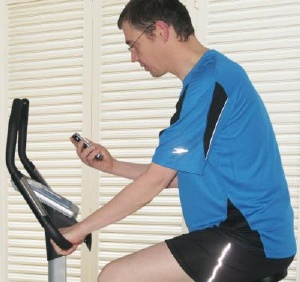May 6 2009
Performance athletes need to know their blood lactate level. It indicates how much lactic acid has collected in their blood as a result of physical exertion and enables conclusions to be drawn about their fitness. Professional athletes therefore regularly have to attend performance diagnosis sessions. As they pedal a cycle ergometer at various levels of exertion, a doctor takes blood samples from an earlobe. A special device then measures the concentration of lactate in the blood.
 Fitness levels are indicated by the lactate value. At present, athletes have to pedal on a cycle ergometer while a doctor takes blood samples. Things will be easier in future. Credit: © Fraunhofer IMS
Fitness levels are indicated by the lactate value. At present, athletes have to pedal on a cycle ergometer while a doctor takes blood samples. Things will be easier in future. Credit: © Fraunhofer IMS
Such scenarios will soon be a thing of the past. Using a miniaturized measuring system, performance and leisure athletes will in future be able to monitor their lactate readings themselves – including during training. Normally the analytical devices are quite big and cost several thousand euros. "We have found a way of miniaturizing the measurement system so that it can be accommodated in an ear clip. The results could be radioed by the ear clip to a training wristwatch or a cellphone," says Thomas van den Boom, group manager at the Fraunhofer Institute for Microelectronic Circuits and Systems IMS in Duisburg. An electrochemical method is used to measure the lactate value. In a chemical reaction, an enzyme triggers a redox flow from the lactate which can be measured using electrodes. The measurement system, which could be installed for example in an ear clip, consists of two microchips: the innovative nanopotentiostat fits on a chip measuring just two by three millimeters and costs less than one euro. "The second chip incorporates microelectrodes which we have developed for this purpose and which we can couple with the nanopotentiostat," explains van den Boom. One of the microelectrodes is coated with a thin layer of gel containing the enzyme. There are altogether three microelectrodes on the chip, which are activated by the nanopotentiostat. Two serve the purpose of electrochemical measurement while the third keeps the electrochemical potential constant end thus ensures a stable voltage.
The engineers can coat the electrode with different enzymes so that, apart from lactate measurement, various other analyses can be performed in the blood or other electrolytes. The advantage is that the electrodes are very small and cheap – and the analyses can be carried out in a mobile environment. A first demonstrator of the nanopotentiostat for lactate measurement (without earclip) has already been produced.